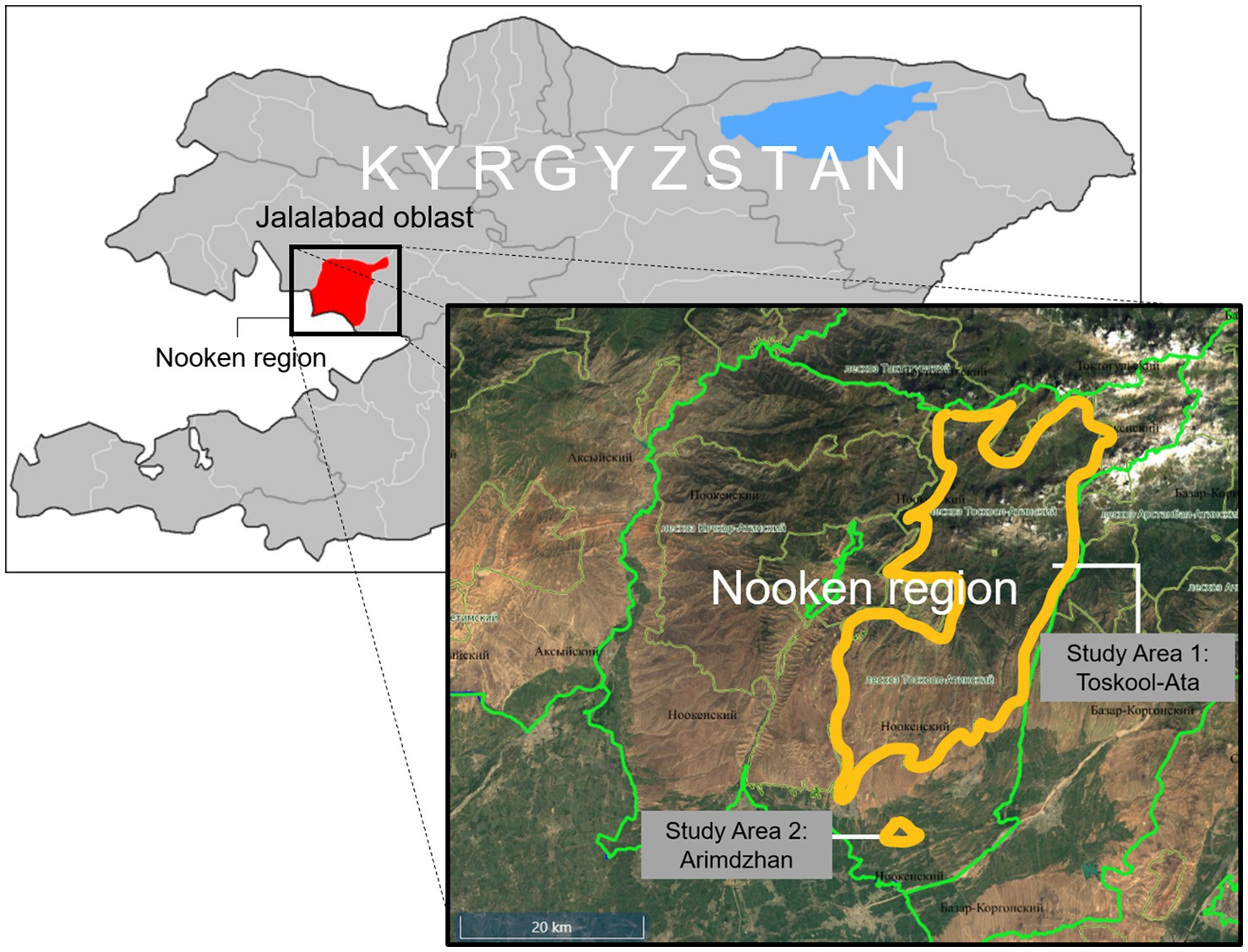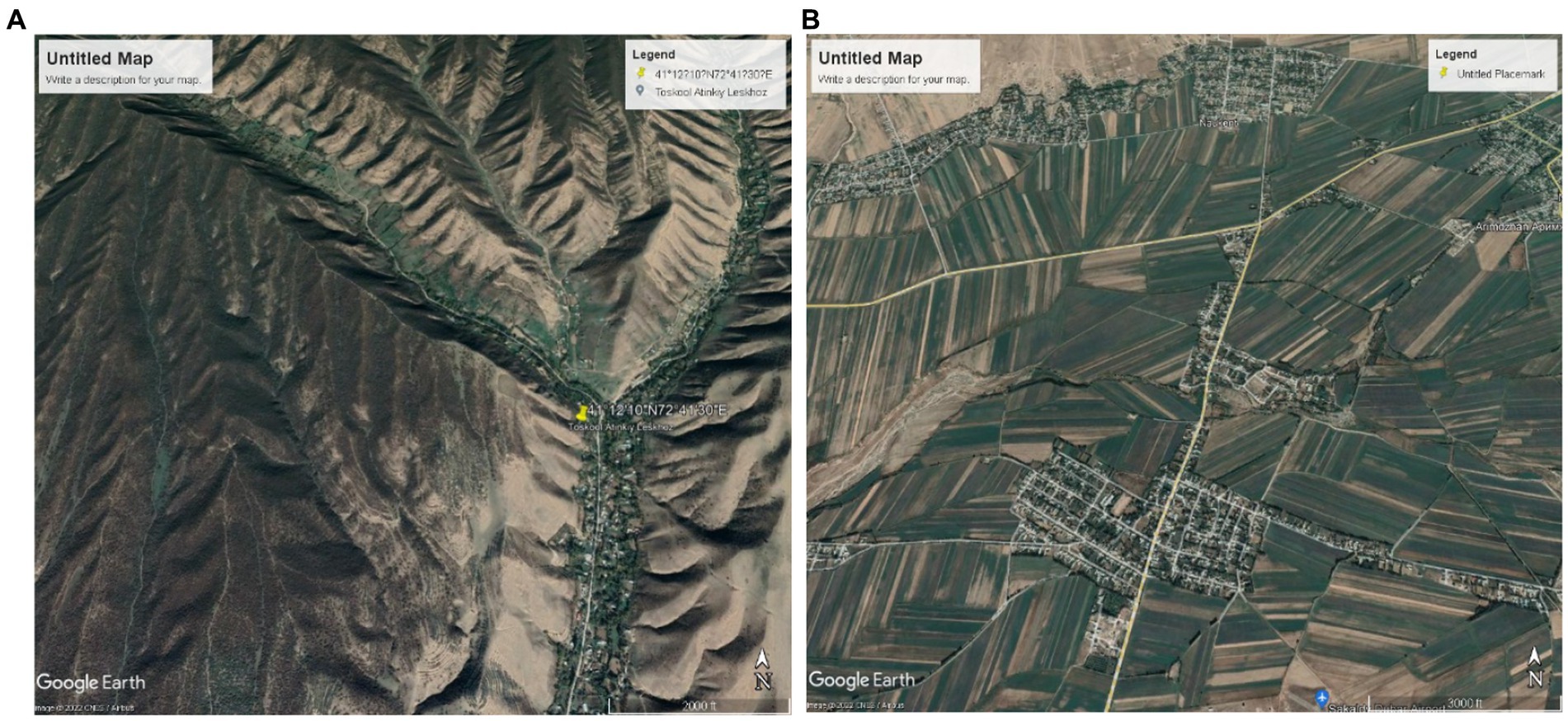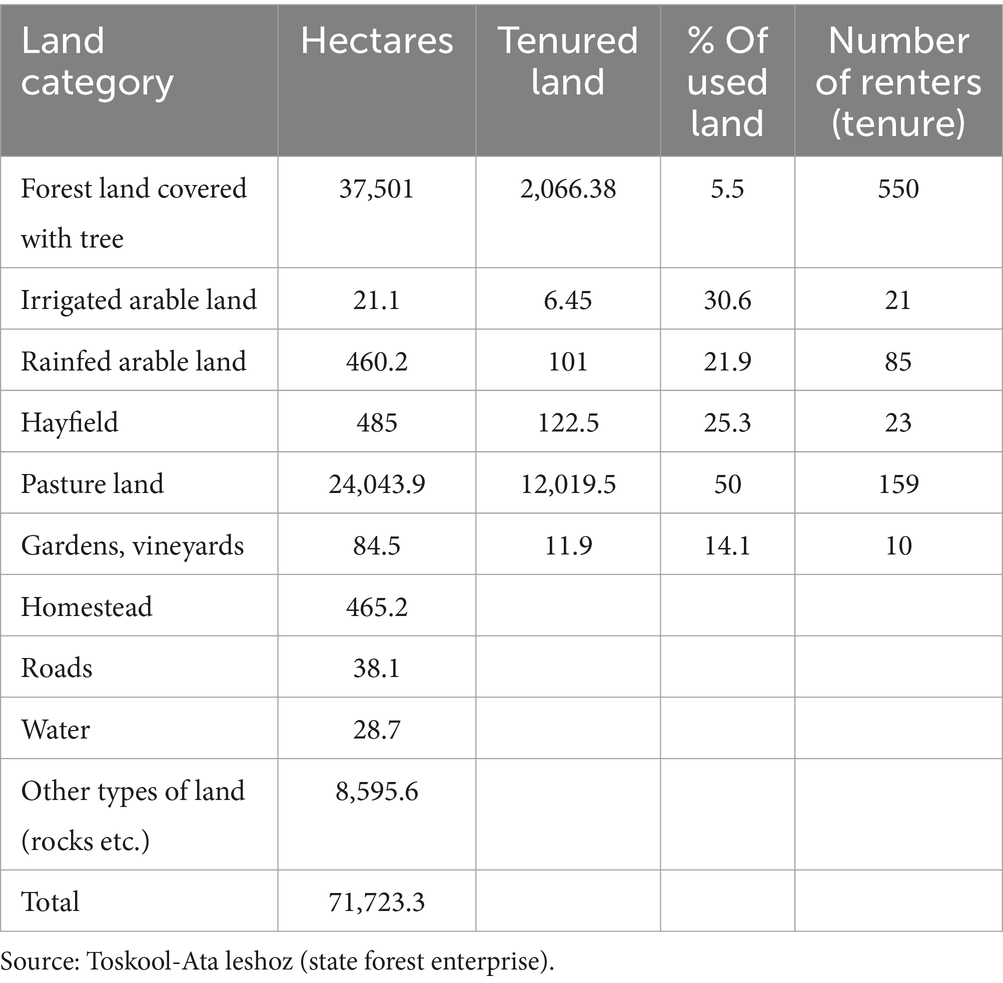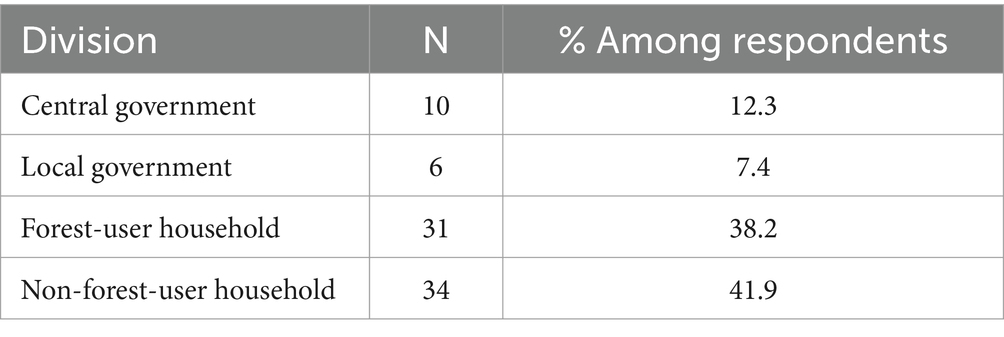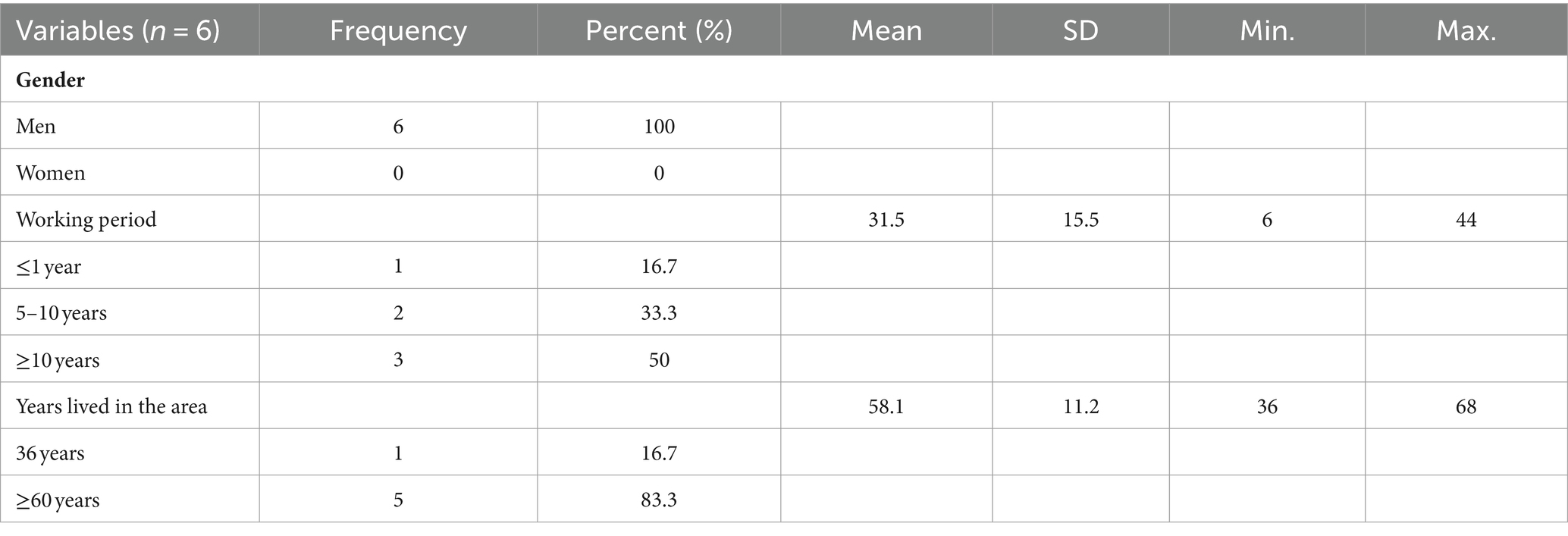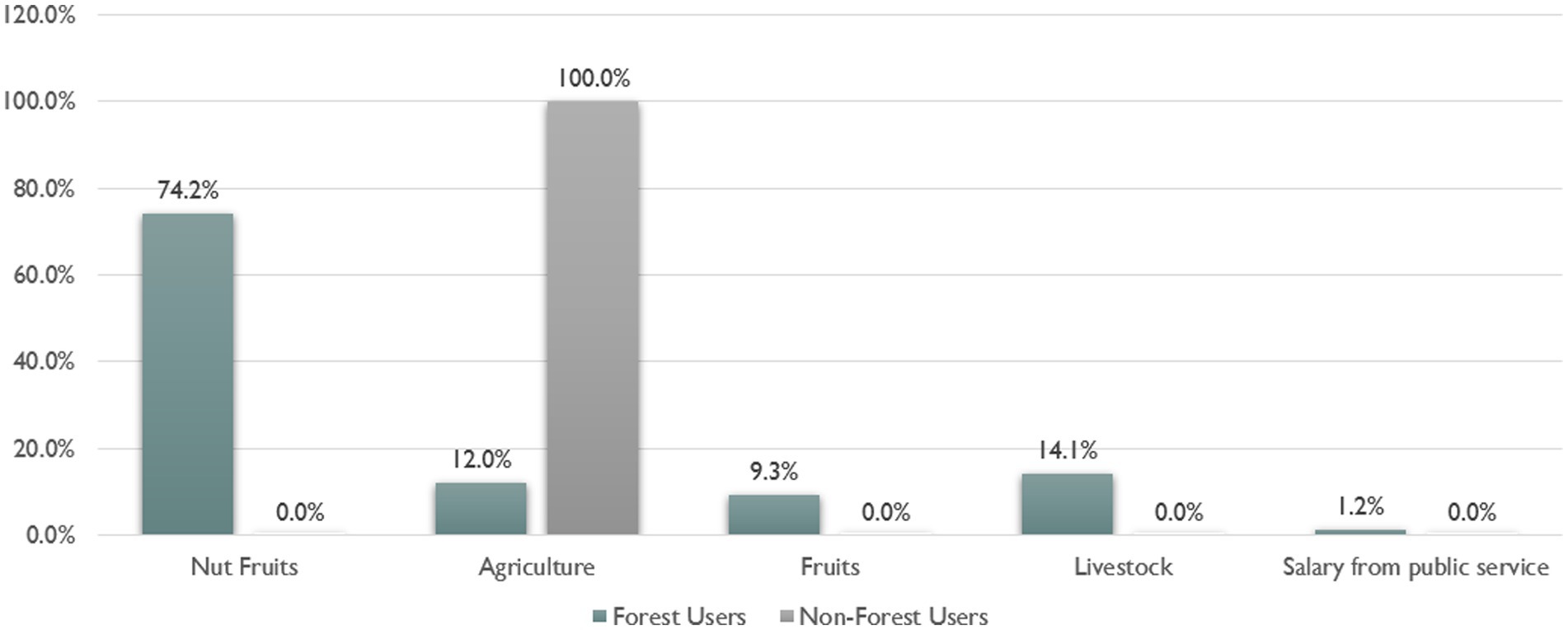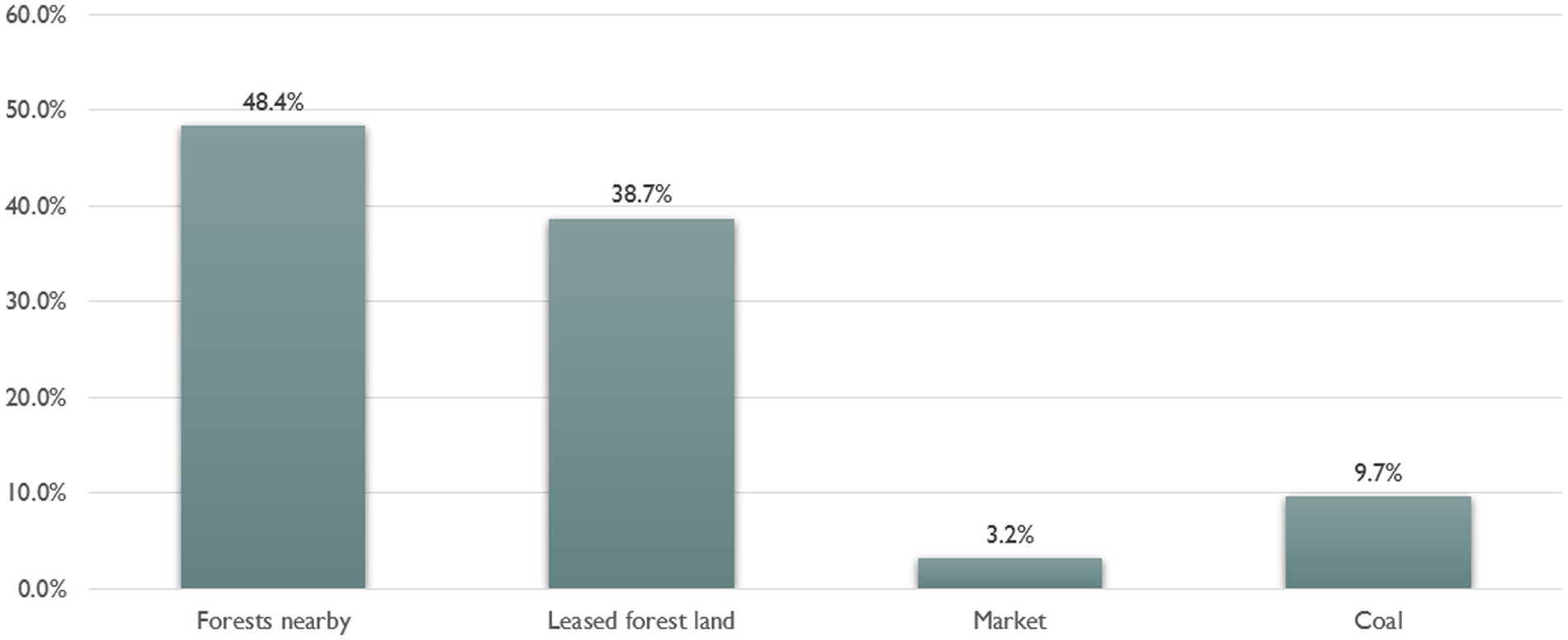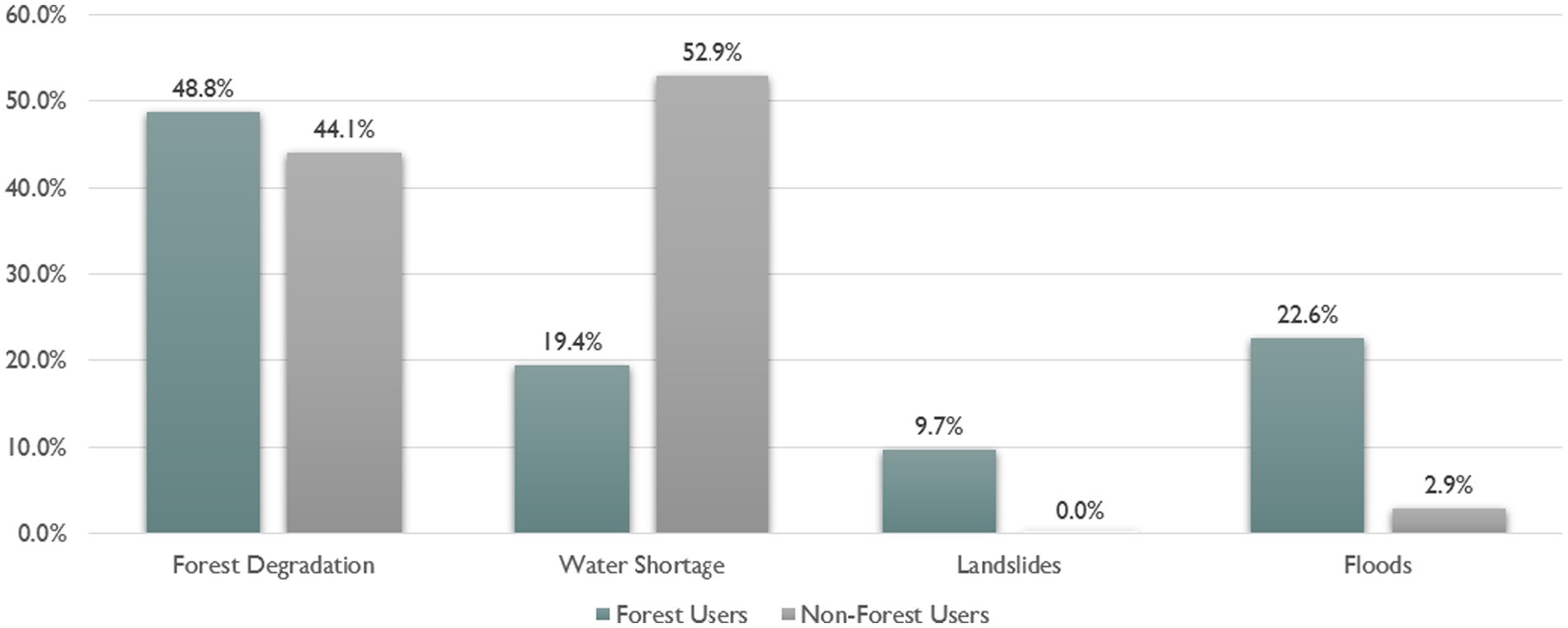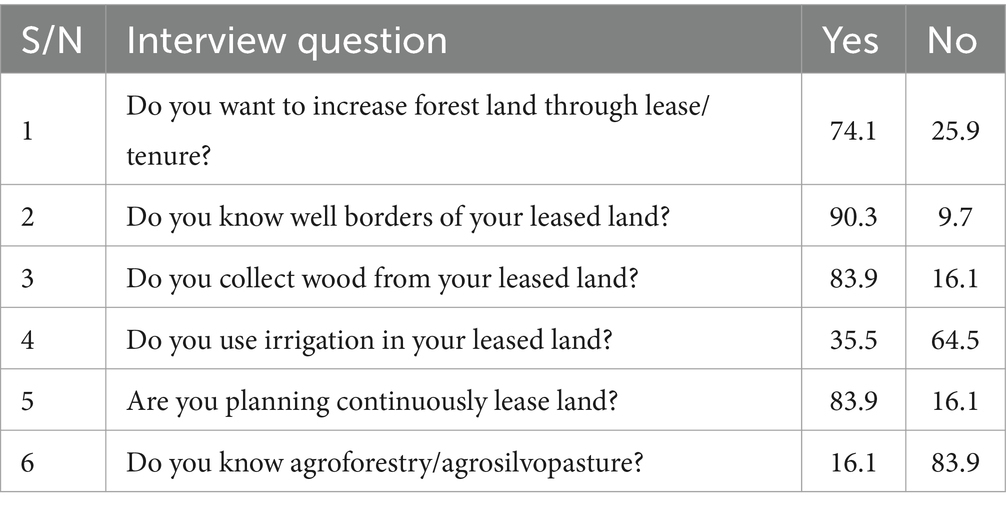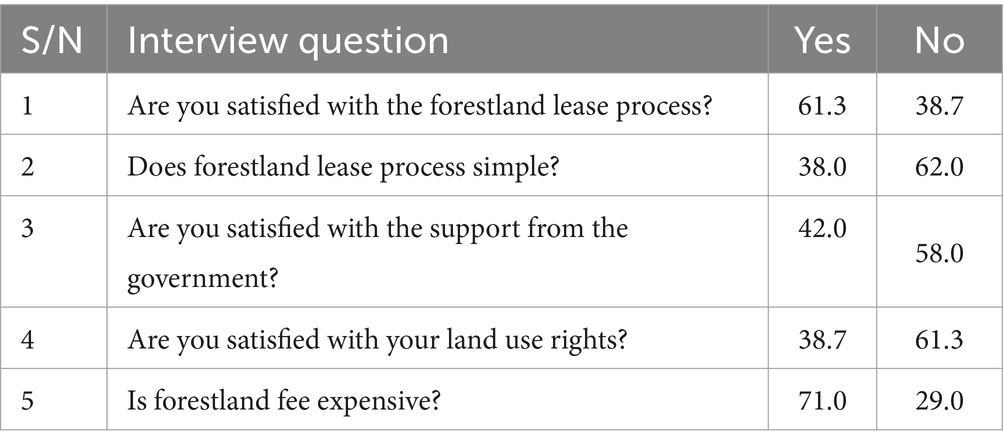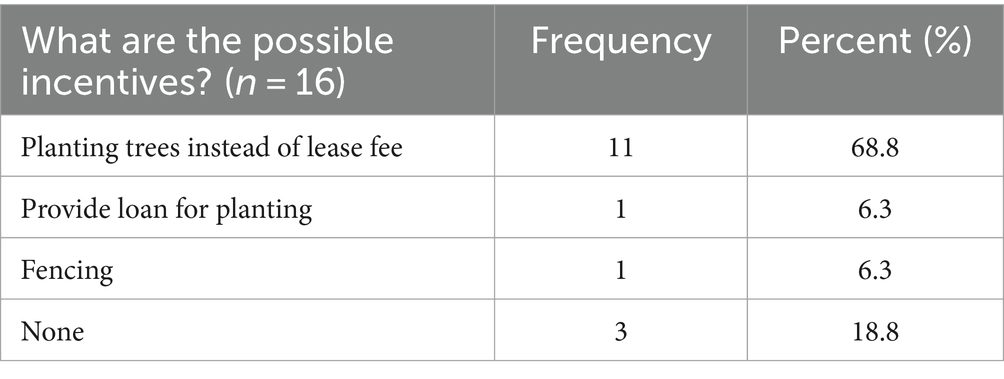Sustainable forest management for nut and fuelwood production in the Jalalabad region, Kyrgyzstan: insights from local communities
- 1Asian Forest Cooperation Organization, Seoul, Republic of Korea
- 2Department of Agriculture, Forestry and Bioresources, Seoul National University, Seoul, Republic of Korea
- 3Research Institute of Agriculture and Life Sciences, Seoul National University, Seoul, Republic of Korea
Jalalabad region in the Kyrgyz Republic is home to the world’s largest natural walnut (Juglans regia L.) forests and pistachio (Pistacia vera L.) forests. These nut-fruit forests serve as the primary source of income for local people; however, deforestation has led to a decline in the availability of these resources. Wood from the forest is also used as a crucial energy source for cooking and heating in this region, despite state protection of the walnut forest due to a lack of alternative energy sources. This study aimed to explore solutions to restore nut-fruit forests while providing a fuelwood source and improving the income of local people. Qualitative research methods were employed, including semi-structured interviews and survey questionnaires with farmers and central and local government officials. The study investigated the main environmental problem of forest degradation and the challenges of forest management, such as livestock and complicated lease arrangements, and determined possible government support and incentives for local communities to participate in forest rehabilitation, such as planting instead of paying lease fees. The findings indicated that a tree-based farming approach can be a promising alternative land-use solution. Seventy-four percent of local farmers expressed their readiness to plant fruit trees and fast-growing tree species to meet their demand for fuelwood and improve their livelihoods if the government can provide temporary fencing support. The study also highlighted the need for capacity building for farmers to learn proper planting, managing, and harvesting for more sustainable practices. Policymakers need to modify legislation through simplified and incentive-based forest lease arrangements.
1 Introduction
Wood and coal are the primary sources of cooking and heating fuel for the majority of households in Kyrgyzstan, and their importance has significantly increased over time (Gottschling and Lazkov, 2005). The use of wood fuel not only serves as a vital energy source but also impacts public interests such as the environment, public health, rural development, employment, and foreign exchange (Githiomi, 2011). Since only approximately 17% of Kyrgyz households have access to modern district heating services, mainly in urban centers such as Bishkek, the majority of households depend on individual heating solutions, with coal being the primary fuel for 60% of them, followed by electricity (15%), wood and dung (5%), and gas (1%) (World Bank, 2020). Although alternative energy sources could help reduce the consumption of firewood in the region, they are limited, particularly for low-income households, due to affordability and infrastructure limitations (Balabanyan et al., 2015). The lower the income, the higher the dependence on solid fuels such as coal, dung, and wood, with 97% of households in the lowest income tertile relying on such fuels for their heating needs.
This overuse of natural forests has led to the depletion of resources and a decrease in the genetic diversity of species in Kyrgyzstan (Rehnus et al., 2013). The harvesting of timber for wood products and grazing remains a major driver of forest degradation, particularly in forests consisting of spruce, juniper, walnut (Juglans regia L.), fruit trees, and pistachio (Pistacia vera L.; Lindquist and Annunzio, 2016). Moreover, the rapid increase in the number of livestock in Kyrgyzstan has led to increased pressure on natural ecosystems, resulting in the degradation of grassland areas near villages (UNECE, 2019).
Previous studies have shown that the Jalalabad region in Kyrgyzstan is a biodiversity hotspot of international significance due to its natural walnut and other fruit forests (Fisher and Christopher, 2007; Venglovskii, 2015). Unsustainable harvesting of non-timber forest products (NTFPs) such as walnut and wild-crafted medicinal plants for export, and the overgrazing of livestock have led to the loss of 90% of fruit and nut forest habitats in the region over the last 50 years (Eastwood et al., 2009; Martínez de Arano et al., 2021). This, coupled with the increasing scarcity of firewood around settlements, has resulted in villagers having to venture further into the forests to meet their daily fuel needs.
In addition to these challenges, climate change is expected to significantly impact the living conditions and health of the population, with water resources being the most vulnerable (International Monetary Fund, Middle East and Central Asia Department, 2023). This will result in a reduction in the development of hydropower, which is the main source of energy in the country (Global Forest Resources Assessment, 2020). Given that people in the region depend on tree resources for quality water, timber, wood fuel, and food, it is crucial to find alternative energy sources and reduce dependency on natural forests as the primary source of fuelwood to prevent desertification and land degradation and mitigate the adverse impacts of climate change.
In order to propose viable solutions to the complex environmental challenges and energy source issues in this region, this study aimed to identify the local community’s willingness to participate in forest rehabilitation by planting fast-growing tree species for fuelwood production to meet the growing demand for fuel. Furthermore, the study examined the perceptions of local forest users regarding the environmental problems related to forest degradation and the challenges in forest management, including complicated lease arrangements and livestock. This study mainly focused on questions about whether forest users were willing to cultivate fast-growing trees and what the locals’ perceptions were regarding environmental problems. Additionally, the study determined the potential government support and incentives available to local communities by asking questions about what incentives the government could potentially provide for forest users.
2 Materials and methods
2.1 Study area
The research was conducted in the Nooken district of the Jalalabad region, as shown in Figure 1. In Kyrgyzstan, all forests and non-forest lands designated for forestry purposes, excluding forests under municipal and private ownership, collectively form the State Forest Fund. The State Forest Fund in this district covers approximately 247,342 hectares, yet only 67,011.9 hectares (27%) are covered with trees, indicating an uneven distribution. They are situated in a ribbon-like formation up to 20 km wide in the northeast, below the belt of alpine and subalpine meadows. The elevation of the district gradually increases from the lower regions, which lie below 1,000 m, to high peaks exceeding 4,000 m.
In order to better understand which factors promote farmers’ environmental behavior, we selected two case study regions to identify similarities and differences in two geographical locations. The first study area selected as a forest user, Toskool-Ata, is located at 41°12′10″N, 72°41′30″E (Figure 2A). These GPS coordinates were received from the local government in charge of forest management in the study area. As illustrated in Figure 2A, areas closer to settlements exhibit degradation as a result of illegal logging and overgrazing, as noted by Beer et al. (2008). In Toskool-Ata, there is a population of 2,180 people (National Statistic Committee, 2021), living on the lower mountain slopes at an altitude of approximately 1,300 m to 1,800 m a.s.l. Forests in the Toksool-Ata region comprise both naturally occurring and human-modified walnut, pistachio, apple (Malus Sieversii M. Roem), and other fruit-bearing tree species distributed in different types of forests (Table 1). These forests are considered a biodiversity hotspot of international importance and have a special regime of use. The area has favorable agro-climatic conditions, with up to 850–1,200 mm of precipitation per year and an average temperature of 20.5°C in July and 3.1°C in January. The region’s natural resources, including agriculture and walnut collection, are important sources of income for local households, along with pasture-based livestock. The usability of pastures depends on altitude, exposure, and water sources. Wood and coal are the main sources of energy for cooking and heating.
Toskool-Ata leshoz, a state forest enterprise that is responsible for the protection and management of forests and state-owned non-forested land located on leshoz territory in the Kyrgyz Republic, was established on 12 March 1997, under Decree No. 142 of the Government of the Kyrgyz Republic. It is located on a single massif, stretching 37 km from north to south and 21 km from west to east. The total area of Toskool-Ata leshoz is 71,723.3 hectares, of which 37,501 hectares (53%) are forests (Table 2). As a government body, the leshoz is responsible for implementing forest policies in line with the Forest Code, with the aims of protecting the forest resources, carrying out reforestation and afforestation, and enhancing the quality of life for the local population (Forest Service of Kyrgyz Republic, 2021).
For comparison with Toskool-Ata, Arimdzhan (41°02′07.0”N, 72°34′55.5″E) was chosen as a sample area representing non-forest users (Figure 2B). Arimdzhan has a population of 2,141, with most individuals engaged in agricultural activities.
2.2 Data collection
Survey questionnaires were used to gather data on forest loss due to illegal harvesting of fuelwood and also to investigate government support and incentives for local communities to participate in forest rehabilitation. Respondents included forest-user households, non-forest-user households, and central and local government officials working in the forestry sector (Table 3). Separate questionnaires were developed for each group and translated into local Kyrgyz and Russian languages for better participation. The survey questionnaires were pre-tested in the field for verification and modifications.
Semi-structured interviews and focus group discussions with experts and stakeholders were also conducted during this period. The aim of the discussions was to understand issues related to access to forest resources, resource use, and recommendations for improving resource governance. Considering approximately 400 households in the study area, 65 heads of households (13% of total households) were interviewed using a simple random sampling based on annual leshoz logs of lease agreements from the past year. This produced a selection of users who have official permits for the use of forest resources and those who do not but still consume them. Sixteen respondents, comprising 10 from the central government and 6 from the local government, were engaged as a sample to gather policy-related information and identify possible incentives for farmers from the government.
2.3 Data analysis
This study employs the theory of planned behavior (TPB) to examine the factors influencing farmers’ perceptions and behaviors regarding tree planting. Developed by Ajzen (1991). TPB is a widely utilized behavioral framework that is considered instrumental in understanding and predicting farmers’ behaviors related to environmental conservation and livestock welfare (Beedell and Rehman, 2000). As an extension of the “theory of reasoned action model,” TPB offers valuable insights into predicting farmers’ behavior, surpassing other socioeconomic variables (Lam, 2006).
Drawing upon questionnaire results, a hypothetical model of farmers’ behavior toward tree planting was constructed. The questionnaire comprised 12 questions assessing perceptions and 12 assessing attitudes, predominantly utilizing a “Yes” or “No” scale. Additionally, warm-up questions, representing various social psychology constructs, were included in interviews to gauge farmers’ perceptions, attitudes, and satisfaction.
Discourse analysis was conducted through interviews with the 16 government officials to explore the types of incentives that the government could offer to encourage local forest users to participate in forest restoration efforts. Both quantitative and qualitative data were edited, numbered, and entered into Statistical Package for Social Sciences (SPSS) 23 software. Multiple response questions were analyzed for frequencies and percentages. Tables and bar charts/graphs were used to present different variables and facilitate the results of the analysis and interpretation of data in Microsoft Excel.
3 Results
3.1 Demographic characteristics of the respondents
3.1.1 Respondents among forest users (Toskool-Ata)
The number of respondents from the forest users was 31, which consisted of 54.9% men and 45.1% women (Table 4). Age groups included 25.8% aged 40–49, 19.3% for both 30–39 and over 60, and 16.1% aged 50–59. Respondent incomes ranged from 1,000 to over 20,000 KGS (equivalent to USD 11–229). Most households near forests had low incomes (15,000 KGS or less, equivalent to USD 172), compared to Kyrgyzstan’s per capita income of USD 1,323 (World Bank, 2020). Household heads were, on average, under 45.7 years old and had a high school education. Approximately 71% of forest users had only a high school education, while 29% held university degrees. As shown in Table 4, 45.1% of respondents had 5–6 family members, and 22.5% had 7–8 family members living together. All respondents reported full involvement in forest-related activities to support their livelihoods. The overall average landholding was approximately 2.8 hectares per household.
3.1.2 Respondents among non-forest users (Arimdzhan)
The number of respondents from non-forest users was 34. Among non-forest users, 61.7% were women and 38.3% were men (Table 5). Age groups included 20.5% aged 40–49, 23.5% aged 30–39, 17.6% over 60, and 26.4% aged 50–59. While 47% were government employees, all had agricultural lands and derived income from them. Respondents’ income ranged from 10,000 to over 100,000 KGS (equivalent to USD 115–1,145). In terms of education, 38.2% graduated from high school, and 58.8% held university degrees. As for family size, 55.8% had 5–6 members, 22.5% had 3–4 members, and 17.6% had 7–8 members living together.
3.1.3 Respondents among central and local government officials
A total of 16 government officials participated in the sampling, including officials from both central and local government institutions. Among the central government officials, 30% were women and 70% were men (Table 6). Their working periods were distributed as 40% with 5–10 years of experience, 30% with over 10 years, and 30% with 1 year or less. In contrast, local government officials were all men (Table 7), and their working periods were divided as 50% with over 10 years, 33.3% with 5–10 years, and 16.6% with 1 year or less.
3.2 Forest use of local communities for economy and fuelwood
The primary economic activity among forest users predominantly involved the collection of nut fruits from the forests, whereas non-forest users overwhelmingly relied on agriculture, constituting 100% of their main economic activity. Within the forest user group, a significant majority, accounting for 74.2% of respondents, highlighted walnut or pistachio collection as their primary income source (Figure 3), indicating a substantial dependency on forest products within the study area.
Among forest users, a significant proportion, comprising 90.3% of respondents, reported utilizing wood for heating and cooking purposes (Figure 4). Of these, 48.4% stated that they source wood from the nearest state forests, while 38.7% indicated collecting wood from their leased forest lands, and 3.2% acquired it from the market. In contrast, respondents among non-forest users mentioned a practice of blending wood with coal and cotton stem, a proportion notably higher than households in non-forest areas, which stands at approximately 20.5%.
Both forest users and non-forest users have expressed concerns about the diminishing availability of fuelwood in the area over time, attributing this trend to deforestation. According to farmers, deforestation primarily stems from overgrazing and inadequate livestock management practices. This indicates a worrying cycle where fuelwood collection and overgrazing contribute to the degradation of forest resources in state forests.
The survey findings highlight that a majority of fuelwood consumption occurs on people’s leased forest lands or nearby forests, where they typically gather wood from dead shrubs or nut-fruit trees. However, it is noted that the availability of dead wood is declining, and people cannot rely on it consistently every year (Gottschling and Lazkov, 2005). Comparatively, among households in forest-user areas, only 9.7% resort to using coal for heating and cooking, sourced from the local market (refer to Figure 4). Respondents attribute their preference for fuelwood over alternative energy sources to the lack of viable alternatives (World Bank, 2019).
3.3 Perception of local people on challenges and capacity building in forest use
3.3.1 Perception of environmental problems
Respondents also displayed a clear understanding of the ecological challenges facing the area, with deforestation emerging as the primary concern. Among forest users, a notable proportion (48.8%) identified forest degradation as the main problem (see Figure 5), while among non-forest user farmers, 52.9% cited water shortage as the primary ecological issue. This discrepancy can be attributed to their main activity, which is agriculture. During interviews, an overwhelming majority of respondents (87.1%) identified overgrazing as the primary driver of deforestation. In contrast, only a minority (12.9%) considered fuelwood collection as the secondary cause of deforestation in the study area.
3.3.2 Growing livestock in the study area
Interviewees emphasized the need for fences on their leased forest land because cattle and other livestock from other households enter the forest land and eat all the young vegetation (Levy Bridges, The World Organization, 2022). This is one reason why households do not want to plant trees on their lands.
3.3.3 Willingness of local people to increase forest land and capacity building
Juldashev and Messerli (2000) identified a major challenge impeding agroforestry adoption in Kyrgyzstan as the perception by farmers that it would lead to the loss of valuable arable land and deprive the farmers of other subsistence agricultural opportunities. However, it was identified through the interview that 74.1% of households are willing to plant trees on their land in order to meet their own fuelwood demand if the government can support temporary fencing. Through the survey, it was also identified that local people are not aware of management through planting mixed tree species (Table 8). Most local communities during the interview showed their interest in learning if the government can provide capacity-building activities in order to enhance the protection status of natural forests and increase the income of dependent communities. Walnut and pistachio are commonly harvested from the forest; however, planting fast-growing tree species such as Populus can be integrated into farming systems around the forest, to provide alternative sources for fuelwood. Furthermore, fast-growing Populus mitigate the negative effects of droughts by absorbing groundwater with its deep roots (Djanibekov et al., 2013).
3.3.4 Satisfaction with the forest lease policy
In order to understand the challenges, through a satisfaction interview on forest lease policy, it was identified that 61.3% of respondents were satisfied, while 38.7% had various challenges, including changes in the forest lease policy (Table 9). A total of 62% of respondents indicated that the forest lease process became complicated, and 61.3% answered that they were not satisfied with the support from the government.
Following a series of interviews with local forest users, it became evident that the majority of community members are generally aware of the arrangements in place for accessing forest resources. However, recent policy changes have left many households unaware of their rights, including the legal and financial aspects, as well as the management of forest lands.
During interviews, several respondents expressed frustration with the allocation of forest lands by the leshoz (forest management authority) to individuals who do not reside in the study area and do not actively utilize the leased forest land, despite the significant reliance of local residents on these resources for their livelihoods. It was noted that leshoz management possesses considerable discretion in simplifying lease procedures, leading to dissatisfaction among the local population.
A total of 70% of respondents among central government officials acknowledged the necessity for a new or modified policy regarding forest land tenure. These observations align with broader economic expectations and highlight the need for further research to assess the impact of improved forest tenure. We anticipate similar findings from research in Toskool-Ata, providing additional insights into the effects of enhanced forest tenure policies.
Traditionally, in addition to livestock production, haymaking and walnut harvesting were the main sources of income in these walnut forests (Rehnus et al., 2013) Investigation through interviews showed that the economic performance of haymaking surpassed that of agricultural crops due to lower inputs such as labor costs.
Due to the lack of budget in the government, only 6.3% of all government officials indicated the possibility of fencing from the government (Table 10).
4 Discussion
4.1 Benefits and impact of forests on the socio-economy of the local people
Forest resources are recognized as readily available and valuable assets that can be harnessed in the battle against rural poverty (Fischman, 2012). The distinctive nut-fruit forests found in Toskool-Ata exemplify the multifunctional utilization of forests. These forests play a significant role in income generation, offering substantial benefits with low labor input and underscoring the importance of nut crops due to their high market value (FAO, 2016). For instance, walnut trees have the potential to significantly alleviate poverty, but it might take approximately 20 years to fully realize the benefits unless fast-growing tree species are planted alongside them (Hardy et al., 2018). Promoting the economic cultivation of local and endemic cultivars presents viable in situ conservation options for preserving genetic diversity as well.
4.2 Perception of local people on local forest-related problems
Farmers who are non-forest users are not familiar with the range of ecosystem services provided and thus have a low perceived value of this land use. The crucial role of forests is mainly recognized by local farmers living near forests, and 48.8% of all respondents indicated that the main ecological problem in the area is deforestation. The lack of perception about various management possibilities in Kyrgyzstan can be explained by the fact that policies were shaped by Soviet Union strategies.
4.3 Willingness to grow fast-growing tree species in order to meet the demand for fuelwood through agroforestry or agrosilviculture
Planting trees provides goods and ecosystem services, offering numerous advantages not only at the household level but also at the village, country, regional, and global levels. These positive impacts are full-value public goods, contributing to food security and income of the rural population, and should be regarded as such Feyisa (2017). Farmers are willing to plant trees since they understand the added value of goods and services, which can increase their financial value (Fleming et al., 2019).
4.4 Challenges in long-term forest land lease/tenure
The majority of the people interviewed indicated that they not only feel insecure leasing the forest lands but there are also more cases of rich people who do not use forests or live nearby leasing forests for the long term. However, they do not do any activities on those lands. When farmers are certain about their land possession, they will be more willing to make long-term investments, such as agroforestry (Djanybekov et al., 2015).
Fencing around the seedling within pastures would prevent livestock from damaging forests and increase its chances of growing. The lack of natural regeneration within pastures might cause a decrease in the overall tree cover and should therefore be brought to the attention of local authorities and organizations (Chamayou, 2011).
4.5 Possible supports or incentives for local communities
National and local incentives are essential to realizing the environmental and economic potential of agroforestry and its contribution to sustainable development in the Central Asian Countries (CACs). The role of the state is important in the development of multifunctional forest management (Fisher et al., 2004) in Kyrgyzstan. In particular, a change in the legal status of land rights is essential. Land and income tax exemptions may be considered to raise the financial attractiveness of agroforestry in the beginning (Norris, 2008). Local support is required to cover initial investments and attract farmers for such land use (Djanybekov et al., 2015). In order to make forestry healthy and sustainable, technical, financial, organizational, educational, and promotional activities are required.
This study posits that the development of incentive-based policies or enhancements to existing policies, such as offering incentives to forest land users for activities such as tree planting in lieu of lease fee payments, could lead to an increase in public goods derived from forest resources (Bruce et al., 2010). Given budget constraints, the government may face challenges in providing additional payments as incentives for local forest land users. However, offering the option to plant trees instead of paying lease or tenure fees could serve as a mutually beneficial solution for both local communities and the government.
5 Conclusion
The pivotal role of forests is widely acknowledged by local farmers residing in proximity to forested areas, with 48.8% of respondents highlighting deforestation as the primary ecological concern in the region. However, due to the absence of alternative energy sources, households are compelled to gather fuelwood from forests. Additionally, livestock grazing within forest lands contributes to vegetation depletion, exacerbating forest degradation. The reliance of local communities on natural vegetation for shelter further underscores their inability to fence leased land due to budget constraints.
This study examined constraints and opportunities for adopting agroforestry practices in the Kyrgyz Republic, utilizing a co-evolutionary socio-ecological systems framework. The framework facilitated the development of guiding questions, semi-structured interviews, and field observations. The findings regarding household characteristics revealed a significant dependence on local natural resources, particularly tree fruits. Given changing climatic conditions, the productivity of walnut forests will be pivotal for resilience.
These findings hold relevance within the global context, as there is increasing attention and support for adopting an ecosystem approach to rehabilitation and ecosystem restoration, particularly through tree planting. Moreover, this research sheds light on the necessity of addressing farmers’ concerns when devising strategies to promote environmentally friendly practices.
The study underscores that farmers’ awareness and satisfaction with forest land lease policies significantly influence their perceptions. Policymakers can leverage drivers of attitudes and perceived behavioral control to steer farmers’ intentions and behaviors toward tree planting for forest restoration. Furthermore, the study reveals that secure land tenure positively impacts farmers’ forest plantation activities and investments, suggesting that government incentives can motivate households to invest more in silviculture.
The preferred government incentive for tree planting, as indicated by respondents, is the fencing of forest lands. However, barriers such as past experiences, lack of knowledge, and inconsistent interpretation of legal rules hinder environmentally friendly behavior among farmers. To address these barriers, this study offers a novel contribution by elucidating the underlying values shaping perceptions of agroforestry.
Policy implications suggest that granting increased freehold land tenure could stimulate forest plantation establishment by farmers. Secured land rights conducive to plantation establishment may motivate more farmers to participate in such initiatives. Recognizing the values driving behavior is foundational for tailoring future approaches to increase agroforestry adoption.
In conclusion, this study suggests that under current conditions, market development for forest plantations can be successful and offer commodity benefits to landowners, consumers, and the country. Expanding similar analyses to other countries with varying political and economic circumstances would further validate the robustness of the study’s findings.
Data availability statement
The raw data supporting the conclusions of this article will be made available by the authors, without undue reservation.
Ethics statement
Ethical review and approval was not required for the study on human participants in accordance with the local legislation and institutional requirements. Written informed consent from the [patients/participants OR patients/participants legal guardian/next of kin] was not required to participate in this study in accordance with the national legislation and the institutional requirements.
Author contributions
AZ: Conceptualization, Data curation, Formal analysis, Investigation, Methodology, Resources, Visualization, Writing – original draft. HH: Conceptualization, Funding acquisition, Project administration, Supervision, Validation, Writing – review & editing. JY: Investigation, Methodology, Resources, Writing – original draft. PP: Supervision, Validation, Writing – review & editing. K-SK: Supervision, Validation, Writing – review & editing.
Funding
This study was carried out with the support of the ‘R&D Program for Forest Science Technology (project no. 2023511A00-2323-AB02)’ provided by the Korea Forest Service (Korea Forestry Promotion Institute).
Conflict of interest
The authors declare that the research was conducted in the absence of any commercial or financial relationships that could be construed as a potential conflict of interest.
Publisher’s note
All claims expressed in this article are solely those of the authors and do not necessarily represent those of their affiliated organizations, or those of the publisher, the editors and the reviewers. Any product that may be evaluated in this article, or claim that may be made by its manufacturer, is not guaranteed or endorsed by the publisher.
Supplementary material
The Supplementary material for this article can be found online at: https://www.frontiersin.org/articles/10.3389/ffgc.2024.1349842/full#supplementary-material
References
Ajzen, I. (1991). The theory of planned behavior. J. Science Direct 50, doi: 10.1016/0749-5978(91)90020-T
Balabanyan, A., Hofer, K., Finn, J., and Hankinson, D. (2015). Keeping Warm: Urban Heating Options in the Kyrgyz Republic – Summary Report (English). Retrieved from World Bank Group. Available at: https://documents.worldbank.org/en/publication/documents-reports/documentdetail/555021468011161504/keeping-warm-urban-heating-options-in-the-kyrgyz-republic-summary-report (Accessed November 27, 2021).
Beedell, J., and Rehman, T. (2000). Using social-psychology models to understand farmers' conservation behaviour. J. Rural. Stud. 16, 117–127. doi: 10.1016/S0743-0167(99)00043-1
Beer, R., Kaiser, F., Schmidt, K., Ammann, B., Carraro, G., Grisa, E., et al. (2008). Vegetation history of the walnut forests in Kyrgyzstan (Central Asia). Quat. Sci. Rev. 27, 621–632. doi: 10.1016/j.quascirev.2007.11.012
Bruce, N., Manber, R., Shapiro, S., and Constantino, M. (2010). Psychotherapist mindfulness and the psychotherapy process. Psychother. Theory Res. Pract. Train. 47:168. doi: 10.1037/a0019833
Chamayou, L. (2011). Farmers’ Perceptions of Trees on Their Land in the Santa Cruz Area, Biological Corridor Volcanica Central-Talamanca, Costa Rica. Available at: https://agritrop.cirad.fr/575305/1/document_575305.pdf (Accessed February 2, 2022).
Djanibekov, U., Djanibekov, N., Khamzina, A., Bhaduri, A., Lamers, J. P. A., and Berg, E. (2013). Impacts of innovative forestry land use on rural livelihood in a bimodal agricultural system in irrigated drylands. Land Use Policy 35, 95–106. doi: 10.1016/j.landusepol.2013.05.003
Djanybekov, U., Dzhakypbekova, K., Chamberlain, J., Weyerhaeuser, H., Zomer, R., Villamor, G. B., et al. (2015). Agroforestry for landscape restoration and livelihood development in Central Asia (Working Paper 186 Ed). Kunming, China: World Agroforestry Centre East and Central Asia.
Eastwood, A., Lazkov, G., and Newton, A. (2009). Retrieved from IUCN. Available at: https://portals.iucn.org/library/sites/library/files/documents/RL-2009-006.pdf (Accessed December 5, 2021).
FAO . (2016). Retrieved from State of the World’s Forests 2016. Forests and Agriculture: Land-Use Challenges and Opportunities. Available at: https://www.fao.org/3/i5588e/i5588e.pdf (Accessed December 10, 2021).
Feyisa, B. N. (2017). Impact of Fuelwood Utilization on Forest Resources in GechiDistrict, South Western Ethiopia. Retrieved from Researchgate. Available at: https://www.researchgate.net/publication/312070001_Impact_of_fuel_wood_on_the_forest_resources_in_south_western_Ethiopia_Gechi_District (Accessed November 1, 2021).
Fischman, E. (2012). The Relevance of Tenure and Forest Governance for Incentive Based Mechanisms: Implementing Payments for Ecosystem Services in Doi Mae Salong. Retrieved from IUCN. Available at: https://www.iucn.org/sites/dev/files/import/downloads/finaltenurepesindms_final_2.pdf
Fisher, B., and Christopher, T. (2007). Poverty and biodiversity: measuring the overlap of human poverty and the biodiversity hotspots. Ecol. Econ. 62, 93–101. doi: 10.1016/j.ecolecon.2006.05.020
Fisher, R. J., Schmidt, K., Steenhof, B., and Akenshaev, N. (2004). Poverty and Forestry: A Case Study of Kyrgyzstan with Reference to Other Countries in West and Central Asia. Retrieved from FAO. Available at: https://www.fao.org/3/j2603e/j2603e00.htm#Contents
Fleming, A., O’Grady, A. P., Mendham, D., England, J., Mitchell, P., Moroni, M., et al. (2019). Understanding the values behind farmer perceptions of trees on farms to increase adoption of agroforestry in Australia. Agron. Sustain. Dev. 39:9. doi: 10.1007/s13593-019-0555-5
Forest Service of Kyrgyz Republic . (2021). Forest Code. Article 37. Rights and Obligations of Leshozes. Available at: https://faolex.fao.org/docs/pdf/kyr26823E.pdf (Accessed November 1, 2021).
Githiomi, J. K. (2011). Turning the Wheels of Rural Life Issue. Available at: http://197.248.75.118:8282/jspui/bitstream/123456789/187/1/turning%20the%20wheels%20of%20rural%20life%20by%20Joseph%20Githiomi%20issue%20no%2012%20oct%20to%20dec%202011.pdf (Accessed November 30, 2021).
Global Forest Resources Assessment . (2020). Retrieved from FAO. Available at: https://www.fao.org/3/ca9825en/ca9825en.pdf (Accessed February 3, 2021).
Gottschling, Z., and Lazkov, G. (2005). Zur Ökologie und Flora der Walnuss-Wildobst-Wälder in Süd-Kirgisistan. Archiv für Naturgeschichte 44, 85–130.
Hardy, K. A., Thevs, N., Aliev, K., and Welp, M. (2018). Afforestation and reforestation of walnut forests in southern Kyrgyzstan: an economic perspective. BioOne Complete 38, 332–341. doi: 10.1659/MRD-JOURNAL-D-17-00046.1
International Monetary Fund, Middle East and Central Asia Department (2023). Climate change adaptation and Mitigation in the Kyrgyz Republic. IMF Staff Country Rep. 2023:A002. doi: 10.5089/9798400232725.002.A002
Juldashev, U., and Messerli, S. (2000). Trees and Agriculture in the Walnut Fruit Forests of Southern Kyrgyzstan: Current Situation and the Potential for Agroforestry. Programme Document of Intercooperation, 1–77. Available at: https://scholar.google.com/scholar_lookup?title=Trees+and+Agriculture+in+the+Walnut+Fruit+Forests+of+Southern+Kyrgyzstan:+Current+Situation+and+the+Potential+for+Agroforestry&author=Juldashev+U&author=Messerli+S&publication_year=2000
Lam, S. P. (2006). Predicting intention to save water: theory of planned behavior, response efficacy, vulnerability, and perceived efficiency of alternative solutions1. J. Appl. Soc. Psychol. 36, 2803–2824. doi: 10.1111/j.0021-9029.2006.00129.x
Levy Bridges, The World Organization . (2022). Kyrgyzstan’s Walnut Forests Dwindle with Increased Cattle Farming, Climate Change. Available at: https://theworld.org/stories/2022-10-18/kyrgyzstan-s-walnut-forests-dwindle-increased-cattle-farming-climate-change (Accessed February 10, 2022).
Lindquist, E. J., and Annunzio, R. D. (2016). Assessing global Forest land-use change by object-based image analysis. MDPI 8, 1–3. doi: 10.3390/rs8080678
Martínez de Arano, I., Maltoni, S., Picardo, A., and Mutke, S. (2021). Non-Wood Forest Products for People, Nature and the Green Economy. Recommendations for Policy Priorities in Europe. A White Paper Based on Lessons Learned from Around the Mediterranean. Knowledge to Action 5, European Forest Institute. Available at: https://efi.int/publications-bank/non-wood-forest-products-people-nature-and-green-economy (Accessed March 15, 2023).
National Statistic Committee . (2021). NatStatCom. Available at: http://www.stat.kg/ru/statistics/gendernaya-statistika/ (Accessed November 20, 2021).
Norris, K. (2008). Agriculture and Biodiversity Conservation: Opportunity Knocks. Retrieved from Society for Conservation Biology. Available at: https://conbio.onlinelibrary.wiley.com/doi/full/10.1111/j.1755-263X.2008.00007.x (Accessed November 25, 2021).
Rehnus, M., Nazarek, A., Mamadzhanov, D., Venglovsky, B. I., and Sorg, J. P. (2013). High demand for firewood leads to overuse of walnut-fruit forests in Kyrgyzstan. For Res 24, 797–800. doi: 10.1007/s11676-013-0367-4
UNECE . (2019). ECE/TIM/DP/72, Forestry and Timber Section, Geneva, Switzerland. Retrieved from United Nations and the Food and Agriculture Organization of the United Nations. Available at: https://unece.org/fileadmin/DAM/timber/meetings/2019/20191216/Forest_Landscape_Restoration_in_Central_Asia_and_the_Caucasus.pdf (Accessed November 20, 2021).
Venglovskii, B. I. (2015). Bioecological peculiarities of renewal and development of walnut forests in Kyrgyzstan. J. For. Res. 11:220.
World Bank . (2019). Learning for the Future (P170542). Retrieved from World Bank. Available at: https://documents1.worldbank.org/curated/pt/912471575390728080/pdf/Concept-Environmental-and-Social-Review-Summary-ESRS-Learning-for-the-Future-P170542.pdf (Accessed March 25, 2022).
World Bank . (2020). Retrieved from World Bank. Available at: https://data.worldbank.org/indicator/NY.GDP.PCAP.CD?locations=KG (Accessed January 15, 2021).
Keywords: wood, fuel, forest rehabilitation, walnut forest, Kyrgyzstan, sustainable forest management, agroforestry
Citation: Zhumasheva A, Han H, You JW, Park PS and Kang K-S (2024) Sustainable forest management for nut and fuelwood production in the Jalalabad region, Kyrgyzstan: insights from local communities. Front. For. Glob. Change. 7:1349842. doi: 10.3389/ffgc.2024.1349842
Edited by:
Gopal Shukla, Uttar Banga Krishi Viswavidyalaya, IndiaReviewed by:
Biplov Chandra Sarkar, GLA University, IndiaZishan Ahmad Wani, Baba Ghulam Shah Badshah University, India
Copyright © 2024 Zhumasheva, Han, You, Park and Kang. This is an open-access article distributed under the terms of the Creative Commons Attribution License (CC BY). The use, distribution or reproduction in other forums is permitted, provided the original author(s) and the copyright owner(s) are credited and that the original publication in this journal is cited, in accordance with accepted academic practice. No use, distribution or reproduction is permitted which does not comply with these terms.
*Correspondence: Hee Han, hee.han@snu.ac.kr
 Aidai Zhumasheva1,2
Aidai Zhumasheva1,2  Hee Han
Hee Han Kyu-Suk Kang
Kyu-Suk Kang